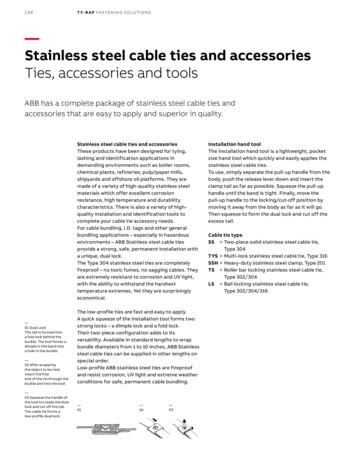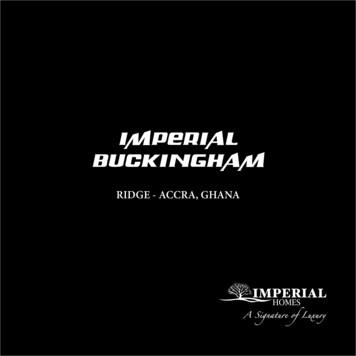Duplex Stainless Steel Fabrication
Duplex Stainless Steel FabricationGary M. CarinciTMR StainlessConsultant forInternational Molybdenum Association1
Promoting molybdenum - as a material with superior properties andperformance in a wide variety of metallurgical, chemical and other productapplications Expanding the applications in which molybdenum is used via: Market development programs Co-operation with consumers, end-users and allied organizations Technical brochures and training seminars to explain the advantagesof using molybdenum-containing products in various industries2
Presentation Overview 3What is Duplex Stainless Steel?Chemical CompositionMechanical cation Cleaning
Types of Stainless Steels4AusteniticType 316FerriticType 430DuplexType 2205
Chemical erritic)162205(duplex)2253
ASTM Mechanical Properties(Minimum 040316L2570402205659525
What is Duplex Stainless Steel?7
Duplex Stainless Steels Consist ofAustenite and Ferrite8
Duplex MicrostructureCourtesy of OutokumpuAusteniteFerrite9
Duplex Stainless Steel Types230423% Cr, 4% NiLDX 210121% Cr, 1% Ni220222% Cr, 2% Ni210221% Cr, 2% NiStandard220522% Cr, 5% NiSuper250725% Cr, 7% NiLean10
Advantages of Duplex 11StrongStress corrosion cracking resistantPitting / crevice corrosion resistantErosion resistantFatigue resistantCost effective (lower nickel contents)
Cutting Stainless Steel12
Cutting Duplex Stainless Steel13 Mechanical Sawing Shearing Abrasive wheel cutting Water-jet cutting Thermal Plasma cutting Laser cutting
Cutting: Sawing 14Similar to austenitic stainless steelPowerful machineProper blade alignmentCoarse toothed bladeSlow to moderate cutting speedHeavy feedGenerous flow of coolant
Cutting, Mechanical Shearing 15More force and heavier equipment will be required toshear stainless steel compared to carbon steelCarbon steel - 1/2” thick shear limitAustenitic stainless steel - 1/4” max.Duplex stainless steel - 3/16” max.
Mechanical Shearing A general clearance guide is to use a clearance of 5% of themetal thickness between shear knivesTo counter the shearing force required for duplex stainlesssteel, the hold down pressure on the clamps may have to beincreased BLADES MUST BE SHARP! 16
Abrasive Cutting 17Abrasive wheels, rotating at highspeed can be used for straightline cutting of sheet and thingauge plate and for cut-offoperations on relative smallsectionsThick section cut-off operationsare usually done wetUse uncontaminated vitrified orresin-bonded wheelsDO NOT INDUCEOVER-HEATING
Cutting: Plasma and Laser 18Same equipment as for 304/316Optimum parameters vary slightly
Bending - Springback19 Duplex stainless steels, with their higher strength andhigher rate of work hardening, require more power tobend than carbon steel Duplex stainless steel must be bent further thancarbon steel to result in the same angle since there ismore springback
Minimum Bending Force3.5Bending Force (kN)3.02.52.01.51.00.50.02022052304Stainless Steel Grades316L
Forming Stainless Steels Duplex stainless steels havehigh work hardening rates the strength increases asthey are formed Greater springback thancarbon steels Avoid contamination fromtooling: Use dedicatedtooling, or provide surfaceprotection21
Avoid Iron Contamination!22
Avoid Contamination fromTooling During Forming 23Ensure particles such as carbon steel or rust arenot pressed into the surfaceAdopt some combination of the followingguidelines: Use dedicated tooling Clean all contamination from the surface oftooling before use Do not use carbon steel tooling - use toolsteel or stainless steel or hard chromeplated tooling Protect the surface of the stainless steel
Cold Forming 24Duplex ductility lower than austenitic avoid sharp bend angle bend radius at least twice the thicknessDuplex much stronger than austenitic higher forces necessary more spring-backDuplex cold works readily Requires more annealing stages than austenitic
Hot Forming25 Avoid critical temperaturerange for sigma phase (1300 - 1800 F) Duplex is very soft between1750 and 2100 F easy to hot form
Hot Forming Temperature RangeGrade26Hot Forming Temperature Range C F22051100 to 9502010 to 174025 Cr Duplex1150 to 9802100 to 179525071200 to 10252190 to 1875Types 304/3161205 to 9252200 to 1700
Hot Forming27 Lower temperature can cause cracking Higher temperature can cause tearing Full solution annealing after hot forming
Minimum Annealing TemperatureGrade C F22051040190025 Cr Duplex104019001025 to 11001875 to 2010Superduplex(depending on grade)28Minimum Annealing Temperature
Machining29
Machining Duplex 30High work hardeningLow thermal conductivityHigh toughness“sticky”Poor chip breaking
General Rules for Machining 31Good edge sharpnessCutting tool with high edge strengthSufficient cutting depthsFrequent insert replacement
ComparisonAustenitic - DuplexAlloy content machinability 32Duplex: harderDuplex: faster strain hardeningHigher tool wearLower machinability
Face Milling with Cemented CarbidesStainless Steelormachining dataLean duplex(2304)2205SuperduplexFeed (per tooth)Depth of cutCarbide Grade33RoughingSpeed (m/min)Speed (sfm)FinishingSpeed (m/min)Speed 0260-36030-50100-16550-70165-2300.2-0.4 mm0.008-0.075 in.0.1-0.2 mm0.004-0.008 in.2-5 mm0.080-0.200 in.1-2 mm0.040-0.080 in.2304, 2205: ISO P20-P402304, 2204: ISO P10-P25Superduplex: ISO P25-P40Superduplex: P20-P30
Summary 34Machinability generally lower than standardaustenitic grades (300-series)Higher forces necessary for machining andformingAdjust parameters to optimize
Duplex Stainless Steel Welding35
Similarities: Austenitic vs. Duplex36 Same pre-weld joint cleaning Remove all debris, dirt, paint and oil Remove water or moisture Same joint preparation Remove heavy oxides Remove rough grinding burrs Same edge geometry Machine or grind edge profile Similar joint design Provide backing gas shielding Ensure full penetration weld
Differences: Austenitic vs. DuplexDuplex weld / HAZ sensitive to: Excessive ferriteSigma phase“You can’t tell from the outside”37
Differences Austenitic vs. Duplex Qualification extremely important 38Appearance of weld gives no indication of qualityWritten procedures and trial welds necessary toassure quality
Differences Austenitic vs. Duplex 39Less thermal expansion - less distortionLess hot crackingSensitive to H2-cracking Remove moisture from joint Store electrodes at elevated temperature Avoid hydrogen in backing or shielding gas
Metallurgy: Phase Balance 40Don’t quench too quicklyNo wash passes or spot weldsIntermediate heat inputFiller metal mandatoryNickel over-alloyed fillerNitrogen in shielding gas is beneficialRemove tack welds in final fabrication
Metallurgy: Sigma Phase 41Don’t cool too slowlyAvoid high heat inputInter-pass temperature 300 FHeat input 15 - 60 KJ/inch (2205)Qualify all welding procedureQualify weld repairs
Welding Processes for DuplexStainless Steel 42Shielded Metal Arc Welding:SMAW, covered electrodes, “stick”Gas Tungsten Arc Welding:GTAW, “TIG”Gas Metal Arc Welding:GMAW, “MIG”Flux Core Arc Welding: “FCAW”Submerged Arc Welding: “SAW”
2205 Welding 43Always use filler metal, even for repairUse 2209 (7 - 9% nickel) filler metalPreheating is not necessaryHeat input 15 - 60 kJ/inchInterpass temperature below 300 FPost-weld heat treatment is not normally necessary.Above 600 F alpha prime precipitation is a concern(885 embrittlement)
Superduplex Welding 44Always use filler metal, even for repairUse 25Cr-10Ni-4Mo-N filler metalPreheating is not necessaryHeat input 15 - 40 kJ/inchInterpass temperature below 200 FPost-weld heat treatment is not normally necessary.Above 600 F alpha prime precipitation is a concern(885 embrittlement)
Dissimilar Metal Welds45 Duplex can be welded to austenitic stainlesssteels and carbon steels E309LMo/ER309LMo or E2209/ER2209 fillerused when welding to austenitic stainless steel E309L/ER309L or E309LMo/ER309LMo fillerused when welding to carbon steels
Welding Consumables Used for Dissimilar Metal Welding2304220525 CrSuperduplex304316Carbon steel462304220525 209309L309LMo220922092209220925Cr-10Ni-4Mo-N 25Cr-10Ni-4Mo-N25Cr-10Ni-4Mo-N 25Cr-10Ni-4Mo-N 25Cr-10Ni-4Mo-N25Cr-10Ni-4Mo-N 25Cr-10Ni-4Mo-N o
Welding Consumables47 Always use a recommended welding product Duplex stainless steel weld fillers are slightlyoveralloyed compared to the base material Composition of consumables is chosen toproduce correct Austenite/Ferrite balance induplex stainless steel welds
Duplex Stainless Steel Shielding Gases48MethodShielding GasesTIGAr or Ar 2 - 3% N2 or Ar 30% HeMIGAr or Ar 2 - 3% N2 or Ar 30% He 1 - 3% CO2 orAr 2 -3 CO2FCAWAr 18 - 25% CO2 or 100% CO2
Good Welding Qualification ToughnessCorrosion resistance e.g., ASTM A 923ASME requirementsMetallographyÎ49Service relevant propertiesare most important
Post Weld Heat TreatmentOnly full solution anneal acceptable! Not normally necessary, except: Autogenous weld (not recommended) Thick weld section with multiple passesto remove sigma phase and restore phase balance50
Post-Fabrication Cleaning Main Objectives are: 51Remove heat tintMake sure there is no surface contamination,such as smeared or embedded ironEnsure there is a strong, continuous, protectivechromium-rich oxide layer all over the surface
Post-fabrication cleaning treatments Blasting (eg. glass beads) Local or large area cleaning Grinding (abrasive discs or flapper wheels) Do not smear (eg. wire brushes) or overheat thesurface (eg. worn abrasives or excessive pressure) Pickling (mixed nitric-hydrofluoric acids) Immersion, spray or paste Electropolishing (electrocleaning) 52Site or shop treatmentBetterresult
Pickling Chemical treatment toremove heat tint, andthe underlyingchromium-depletedlayer and surfacecontamination Covered by:ASTM A 38053Pickling with paste
Spray Pickling54
PicklingAfterBefore55
Duplex Stainless Steel Fabrication HandbookPublication was revisedin 2009 and will beprinted by IMOANew duplex stainlesssteel grades are includedin the revision56
Duplex Stainless Steel Fabrication Handbook. Title: Microsoft PowerPoint - Gary Carinici - Duplex F
DNV-RP-F112 – October 2008 Scope: This is a recommended practice covers all components made from duplex stainless steel that are installed subsea and are exposed to cathodic protection Material requirement of duplex/super duplex Stainless steel according to DNV-RP-F112 Material should be solution annealed and water quenched.
SS Two-piece solid stainless steel cable tie, Type 304 TYS Multi-lock stainless steel cable tie, Type 316 SSH Heavy-duty stainless steel clamp, Type 201 TS Roller bar locking stainless steel cable tie, Type 302/304 LS Ball locking stainless steel cable tie, Type 302/304/316 — Stainless steel cable ties and accessories Ties .
Welding duplex and super duplex stainless steels is similar to welding austenitic stainless steels; however, critical steps must be taken to maximize both corrosion resistance and mechanical properties. Where maximum results are necessary, such as in corrosive service applications, selecting the proper
What is the “Family” Lean Duplex SS – lower nickel and no molybdenum – 2101, 2102, 2202, 2304 Duplex SS – higher nickel and molybdenum - 2205, 2003, 2404 Super Duplex – 25Chromium and higher nickel and molybdenum “plus” – 2507, 255 and Z100 Hyper Duplex – More Cr, Ni, Mo and N - 2707
ASTM A193-B8 ASTM A194-8 ASTM A276-F316 Stainless Steel Stainless Steel ASTM A193-B8 Stainless Steel Stainless Steel Stainless Steel Stainless Steel VITON GLT(-46 C) Teflon * Only applies to Class 1500 Valves DUE TO CONTINUOUS DEVELOPMENT OF OUR PRODUCTS, WE RESERVE
grade BLUM hinges and accessories. Stainless steel oven Stainless steel 5-zone glass gas hob Stainless steel integrated microwave Stainless steel integrated fridge and freezer Stainless steel integrated dishwasher Stainless steel washing m
4 Nuts 316 Stainless Steel - anti-galling compound coated / AS 1112.1 5 Washers 316 Stainless Steel / ISO 7089 6 Bridge Plate 316 Stainless Steel bonded to gasket ASTM A240M 7 Lugs 316 Stainless Steel / ASTM A240M 8 Flat Bars 316 Stainless Steel / ASTM A276 or A240M 9 Sealing Gasket Full-circle Nitrile / (NBR) Compound AS 1646 and AS/NZS 4020 .
making formal decisions at the final “appeal” stage of our process (see page 75 for more details ) All figures relate to the financial year 2012/2013. 4 annual review 2012/2013 . Financial Ombudsman Service Financial Ombudsman Service . annual review 2012/2013 5. chairman’s foreword. Sir Nicholas Montagu . kcb. we have resolved . more cases. than in any previous year – and each of .























